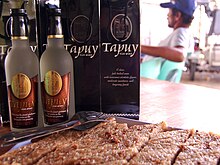Philippine wine

Philippine wineorFilipino wineare variouswinesproduced in thePhilippines.They include indigenous wines fermented frompalm sap,rice,job's tears,sugarcane,andhoney;as well as modern wines mostly produced from various fruit crops.
Pre-colonial
[edit]
Indigenous wine-making traditions in the Philippines dates back to before thecolonization of the islands by the Spanishin the 16th century. They were usually part of the traditionaltapayfermentation process and were fermented inside earthen jars known astapayan.They were consumed both for recreation and in theanimistrituals in the various indigenousanitoreligions. Heavy consumption of tubâ and other alcoholic beverages in the Philippines were reported by early Spanish colonizers.Social drinking(tagayanorinumaninTagalogandVisayan languages) was and continues to be an important aspect of Filipino social interactions.[1][2][3]Indigenous wines include the following:
Palm wines
[edit]Among the most widely prevalent wines produced in the Philippines is thetubâwhich is produced from palm saps. The most common types oftubâare made fromcoconutandnipa palmsap.Tubâcan also be made from the kaong palm (Arenga pinnata) andfishtail palms(Caryotaspp.), which are known astuhakandtunggang,respectively.[4][5]
A notable variant oftubâfrom theVisayan peoplesofVisayasandMindanaois thebahalina,which is distinctively reddish-brown in color due to the use of bark extracts from certain mangrove species.Tubâis also commonly consumed with raw egg yolks and other sweet ingredients, a combination known askinutil.[6][7][8]
During theSpanish colonial period,distillationtechnologies were adopted by native Filipinos as early as 1574, resulting in improvisedstillsknown askawa.These were used to distill tubâ into a palmliquorknown asvino de cocoorvino de nipa,which is now known aslambanógin modern times.[1]
Rice wines
[edit]
Rice wines used to be common in pre-colonial times, as part of the process oftapayproduction, but now only survive among relatively isolated ethnic groups in the islands. Thepangasiof theVisayans,for example, is now virtually extinct. However, a version survives among theSubanen people,which can also be made fromjob's tears(adlay), though even this is starting to disappear as the starch source is increasingly being replaced bycassava.Pangasialso survives among theSulodnon peopleofPanay,though it has also been replaced withsugarcane.[1][9][10][11]
Among theManobo peopleofBukidnon,a similar rice wine exists calledagkud.It is flavored with ginger and sugarcane juice.[12]In the northern Philippines, the only surviving rice wine is thetapuyof theIgorot people,also known locally asbaya.It is mixed with ginger and roots. It is a very important part of traditional rituals of the highland tribes.[4][13]
Sugarcane wines
[edit]Sugarcane wines include thebasiof theIlocanosand thepalekof theIvatan.Basiis notable in that it caused the 1807Basi Revoltwhen Spanish authorities tried to ban the private manufacture ofbasi.[14]
Another sugarcane wine was theintusof Visayas and Mindanao. It is largely extinct,[9][15][16]though it still partially survives among theLumad peoplesof Mindanao where it is flavored withlangkawas(Alpinia galanga) orpal-la(Cordyline fruticosa) roots.[17]
Mead
[edit]Meadmade from honey were rare, even in precolonial times. They are now extinct and only known from colonial sources. They include thekabarawanof theVisayanswhich was made from honey mixed with bark from the kabarawan tree (Neolitsea villosa); and thebaisof theMandayaandManobo peoplewhich is made from honey and water.[17]
Modern wines
[edit]Most of the modern wines produced in the country are based on locally produced crops withgrape-based winesmostly imported fromAustraliaandEuropeancountries.[18]In 2012, it was reported that previous attempts to produce grapes which are suitable enough for wine making in northern Philippines failed due to unsuitable soil conditions and high temperatures.[19]
Modern local wines are mostlyfruit wines,includingbignay winemade from bignay berries (Antidesma bunius);[20][21][22]guyabano winemade fromsoursop(Annona muricata);mangosteen winemade frommangosteen;duhat winemade from black plum (Syzygium cumini);[23][24][25]andmango winemade fromPhilippine mangoes.[26][27][28]Another locally produced wine isoregano winefromQuezonproduced fromCuban oregano(Plectranthus amboinicus).[29]
Liqueursproduced from the colonial era are also commonly sold as "wine". The most popular areanisado,anise liqueursgenerally infused with various herbal ingredients by earlyChinese-Filipinoimmigrants. A notable variant ofanisadoisanisado Mallorca,or simplyMallorca,which adds sugar and can also be used as a cooking wine.[1][16]
References
[edit]- ^abcdGibbs, H.D.; Holmes, W.C. (1912)."The Alcohol Industry of the Philippine Islands Part II: Distilled Liquors; their Consumption and Manufacture".The Philippine Journal of Science: Section A.7:19–46.
- ^Lasco, Gideon."Tagay: Why there's no Tagalog word for" cheers "and other notes on Filipino drinking culture".Health, Culture, and Society in the Philippines.Retrieved6 May2019.
- ^Garcia, Lawrence."Tagay: A Look at Philippine Drinking Culture".Humaling.Retrieved6 May2019.
- ^abPolistico, Edgie."Tungog".Philippine Food Illustrated.Retrieved21 April2019.
- ^"How Tuba and Bahalina, Also Known as Coconut Wine, Are Made".Delishably.Retrieved21 April2019.
- ^"Do You Know What Kinutil Is?".Bite Sized.Retrieved5 May2019.
- ^Damo, Ida."Kinutil: The Filipino Mudslide Drink".ChoosePhilippines.Retrieved5 May2019.
- ^"Comfort food ng mga Waray".Kapuso Mo, Jessica Soho.GMA Public Affairs.Retrieved5 May2019.
- ^abDemetrio, Feorillo Petronilo A. III (2012)."Colonization and Alcoholic Beverages of Early Visayans from Samar and Leyte".Malay.25(1): 1–18.
- ^Gico, Emma T.; Ybarzabal, Evelyn R."Indigenous Rice Wine Making in Central Panay, Philippines".Central Philippine University.Retrieved4 May2019.
- ^Jocano, F. Landa (1958). "The Sulod: A Mountain People In Central Panay, Philippines".Philippine Studies.6(4): 401–436.JSTOR42720408.
- ^Caldo, Gloria A.; Hiroshige, Sakai (1985). "Microbiological studies on pangasi, a rice wine in Mindanao".The Philippine Agriculturist.68(4).
- ^Rice Wine Technology Bulletin,Philippine Rice Research Institute (2000)
- ^"Chapter 3: Pre-colonial Philippines".Philippine History.Rex Bookstore. 2004. p. 60.ISBN9789712339349.Retrieved1 January2017.
- ^Feraren, John Mychal."Ten Proofs We Inherited Our Love for Drinking from Pre-Colonial Filipinos".Claire Delfin Media.Archived fromthe originalon 9 May 2019.Retrieved5 May2019.
- ^abAranas, Jennifer (2015).Tropical Island Cooking: Traditional Recipes, Contemporary Flavors.Tuttle Publishing. p. 11.ISBN9781462916894.
- ^abGarvan, John M. (1912)."Report on the drinks and drinking among the Mandaya, Manobo, and Mangguangan Tribes".The Philippine Journal of Science: Section A.7:106–114.
- ^"The Philippine Wine Industry".Wanzui.Beijing Realce Investment Industry Co., Ltd.Retrieved1 January2017.
- ^Beltran, Cito (3 February 2012)."Do they make wine in the Philippines?".CTALK.The Philippine Star.Retrieved1 January2017.
- ^Miranda, Roselle."Duhat And Bignay Are The Fruits You Should Be Drinking".Yummy.ph.Retrieved5 May2019.
- ^Piccio, Belle."Proudly Filipino: Wonder Wine from the Country's Sugar Capital".ChoosePhilippines.Retrieved5 May2019.
- ^"How to Make Bignay Wine".Business Diary Philippines.Retrieved5 May2019.
- ^Lagsa, Bobby."The women wine makers of Bolisong".Rappler.Retrieved5 May2019.
- ^"How to Make Duhat Wine".Business Diary Philippines.Retrieved5 May2019.
- ^Miranda, Roselle."Duhat And Bignay Are The Fruits You Should Be Drinking".Yummy.ph.Retrieved5 May2019.
- ^dela Cruz, Aissa (26 November 2011)."A toast to Conrad's Mango Wine".Philippine Daily Inquirer.Retrieved18 November2019.
- ^"How to Make Mango Wine".Business Diary Philippines.5 September 2019.Retrieved18 November2019.
- ^Ramoran, Carol (25 February 2014)."Mango rum, barako liqueur, and more local drinks to try".Rappler.Retrieved1 January2017.
- ^Valmero, Anna (17 September 2012)."Quezon's oregano wine makes it to wine festival in Italy".Science.ph.Retrieved18 November2019.

